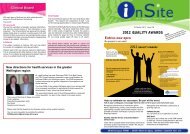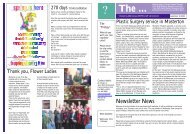Te Arawhata Totika - Wairarapa DHB
Te Arawhata Totika - Wairarapa DHB
Te Arawhata Totika - Wairarapa DHB
You also want an ePaper? Increase the reach of your titles
YUMPU automatically turns print PDFs into web optimized ePapers that Google loves.
hOkAi rAuru Nui<br />
Is used in this waiata to mean a problem free birth, every thing is as it should be<br />
having an understanding of these values is one thing,<br />
knowing how to apply them in a hauora setting is<br />
another. For <strong>Te</strong> <strong>Arawhata</strong> Tötika to be successful<br />
we need to ensure the essential elements of practice<br />
that give the identified values substance are utilised<br />
to support the integration of these values into daily<br />
health practice. These are Tikanga/kawa and<br />
<strong>Te</strong> reo Mäori<br />
Tikanga/Kawa<br />
Tika literally means to be right, and focuses on<br />
the correct way of doing something. it provides<br />
a system that deals with the norms of society.<br />
As such, tikanga is an essential part of Mäori<br />
knowledge and provides the processes by which<br />
hauora can be achieved. it reflects the knowledge<br />
and the wisdom of our tipuna, fosters wellbeing<br />
and has the capacity to strengthen and calm<br />
situations whether spiritual or physical in origin.<br />
Tikanga is not a static concept; it can change its<br />
focus over time in response to the changes that<br />
occur in one’s circumstances, in changing lifestyles<br />
and the requirements these place upon us.<br />
The concept of tikanga remains central to<br />
our understanding and reflects the teachings<br />
we have received from tipuna, koroua,<br />
kuia and other significant people.<br />
Tikanga exists within hauora and is part of the<br />
interconnectedness of the values that shape it.<br />
There is tikanga that is associated with childbirth,<br />
the gathering of kai, there is in fact tikanga<br />
that guides us in everything that we do.<br />
In today’s world tikanga has a changing meaning.<br />
we were taught about tikanga by our koro<br />
and kuia and these teachings came from our<br />
tipuna. understanding tikanga and incorporating<br />
it into your life shapes your wellness.<br />
Marsden (royal 2002) states that tikanga is the<br />
value that provides the appropriate actions and<br />
responses to what is morally and socially correct.<br />
For the wairarapa DhB there is tikanga that<br />
surrounds all of its policies and procedures. The<br />
use of powhiri, for all staff promotes the concept<br />
of whänaungatanga and has been adapted to a<br />
DhB environment while retaining wairarapa kawa.<br />
The introduction of Tiriti o waitangi training for all<br />
employees is another example. At an operational<br />
level the implementation of the Tikanga Best<br />
Practice Guidelines (Naida Pou, Auckland DhB) are<br />
integrated into wairarapa DhB daily health practice.<br />
<strong>Te</strong> Reo Mäori<br />
<strong>Te</strong> reo Mäori is the language given to us by our<br />
tipuna; it is ours and should not be compromised.<br />
when something is expressed in the Mäori<br />
language it carries with it a deeper meaning<br />
which has special significance to the speaker.<br />
The speaker hopes to communicate the<br />
meaning and the way in which they are using the<br />
language to the person(s) being spoken to.<br />
<strong>Te</strong> reo Mäori is recognised as having its source<br />
within the teachings of our tipuna. it expresses our<br />
thoughts, customs, hopes, frustrations, history,<br />
mythology, dreams and knowledge. without <strong>Te</strong><br />
reo Mäori we cannot have a unique identity, nor<br />
can we accumulate the power that is expressed<br />
within our Tino rangätiratanga. <strong>Te</strong> reo Mäori<br />
encompasses the mana, mauri, tapu concepts.<br />
Marsden expresses that Mäori view is comprised of<br />
a three-world view; the world of sense per ception<br />
(physical), the world that exists behind that of<br />
the world of sense-perception (spiritual) and the<br />
world of symbol, which is encapsulated in te reo<br />
(the language). By analysing the root meaning of<br />
words, the relationships between words in stylised<br />
sentences, the symbolic and evocative value<br />
attributed to each, and by a study of grammatical<br />
constructions peculiar to Mäori, the inner thought<br />
and psychological thinking responsible for such<br />
constructions and methods of expression become<br />
explicit and highlight cultural values (Marsden, 1975).<br />
The connectedness between the spiritual, the<br />
environment and ones physical self is captured<br />
in te reo Maori (the language). <strong>Te</strong> reo rangätira<br />
is a taonga (treasure) and emphasises and<br />
maintains the values held within the culture.<br />
Durie provides examples of how language is a<br />
conveyer of values, principles and worldviews.<br />
<strong>Te</strong> <strong>Arawhata</strong> Tötika Cultural Competency Framework<br />
23







